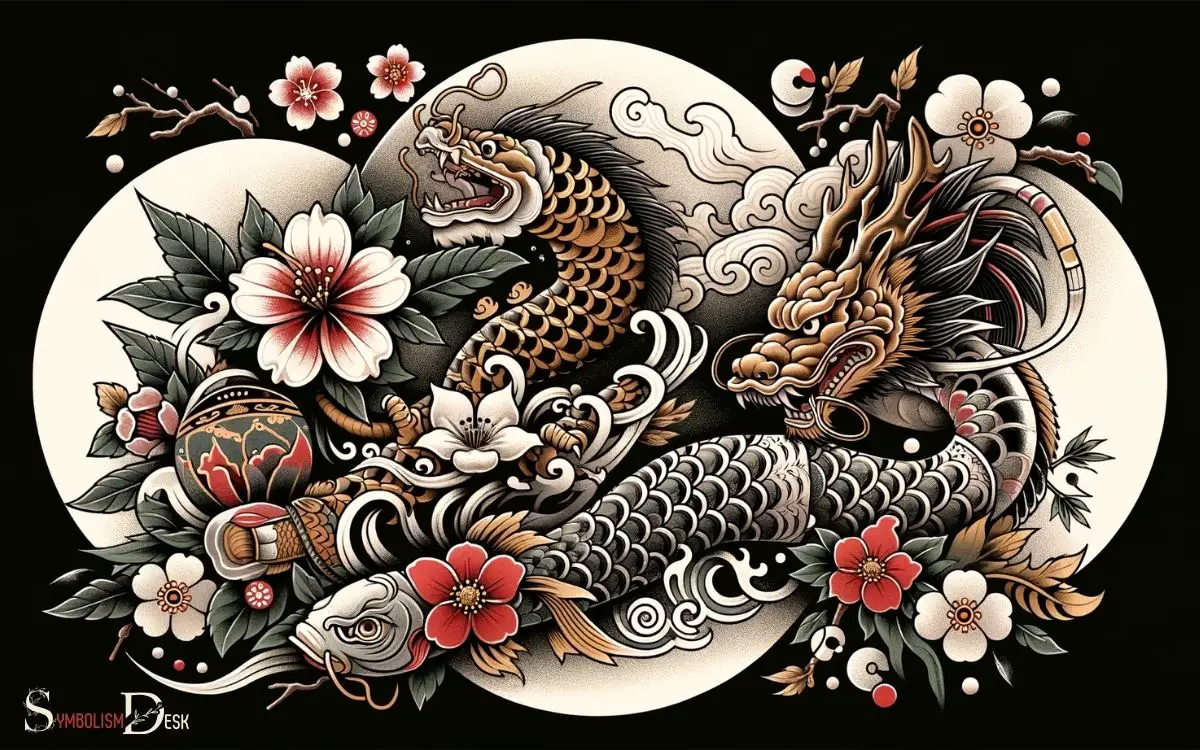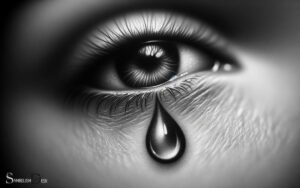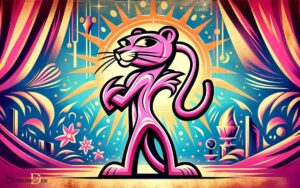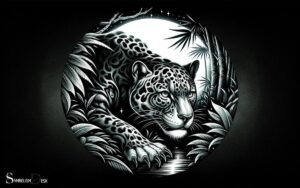Japanese Tattoo Symbols and Meanings: Strength!
Explore the profound world of Japanese tattoo artistry, a realm where each design is imbued with symbolic meaning and cultural depth.
Japanese tattoos, or Irezumi, feature elements like koi fish, representing perseverance; cherry blossoms, symbolizing the ephemeral nature of life; and dragons, denoting wisdom and strength.
These tattoos are not only aesthetically striking but also serve as a narrative of personal significance or cultural heritage.
Japanese tattoo symbols are often chosen for their aesthetic appeal and the values they represent.
Some common motifs include:
- Koi Fish: Often a symbol of overcoming adversity, it represents strength and determination.
- Cherry Blossoms (Sakura): These delicate flowers are a reminder of life’s fleeting beauty and are associated with mortality.
- Dragons: In Japanese culture, dragons are wise and powerful beings that can bring fortune or destruction.
- Phoenix (Hou-ou): A symbol of rebirth and triumph over adversity.
- Tigers: They signify protection against bad luck and disease.
- Samurai: Represent honor, bravery, and the bushido code.
- Oni (Demons): Can symbolize protection from evil or bad spirits, despite their fearsome appearance.
These symbols can be intricately combined to tell a story or convey the wearer’s aspirations, beliefs, or experiences.
Delve into the intricate world of Irezumi, where every stroke is a testament to both personal journeys and an age-old cultural legacy.

Key Takeaway
Origins of Japanese Tattoo Art
The origins of Japanese tattoo art can be traced back to the Jomon period, around 10,000 BCE, when evidence of tattooed figurines and clay figures was discovered.
The Jomon people, who were the first major culture in prehistoric Japan, are believed to have practiced tattooing for spiritual and decorative purposes.
They used tattoos to signify tribal affiliations, protect against evil spirits, and mark significant life events.
This ancient form of body art laid the foundation for the development of traditional Japanese tattooing, which has evolved over thousands of years.
The intricate designs and symbolic meanings associated with Japanese tattoos have deep cultural and historical significance.
Understanding the origins of Japanese tattoo art provides insight into the rich cultural heritage and symbolism that continues to influence contemporary tattoo practices.
Traditional Japanese Tattoo Symbolism
Japanese tattoos carry deep symbolism and cultural significance. Each design represents a specific meaning or value. Traditional Japanese tattoo art is rich in symbolism, drawing from centuries of history, folklore, and spirituality.
It creates powerful visual narratives. Understanding the traditional symbolism behind these tattoos provides insight into the complex and meaningful world of Japanese body art.
Symbolism in Japanese Tattoos
Traditional Japanese tattoos incorporate a rich array of symbols with deep cultural and historical significance. These tattoos often feature elements such as dragons, koi fish, cherry blossoms, and peonies.
The dragon represents strength, courage, and magic, while the koi fish symbolizes perseverance and determination.
Cherry blossoms are associated with the transience of life and the beauty within that fleeting existence. Peonies, on the other hand, are a symbol of wealth, good fortune, and bravery.
These traditional Japanese tattoo symbols are carefully chosen to convey specific meanings and often form larger motifs that tell stories or represent personal journeys.
Each symbol holds a profound significance and is deeply rooted in Japanese mythology and folklore, making these tattoos not only aesthetically striking but also culturally rich and meaningful.
Cultural Significance of Designs
Incorporating a rich array of symbols with deep cultural and historical significance, traditional Japanese tattoos convey profound meanings deeply rooted in mythology and folklore.
The cultural significance of these designs reflects traditional Japanese values, beliefs, and stories, making them an essential part of the country’s artistic and historical heritage.
Below is a table depicting some common traditional Japanese tattoo symbols and their meanings:
| Symbol | Meaning |
|---|---|
| Koi Fish | Perseverance, strength |
| Dragon | Power, wisdom, protection |
| Cherry Blossom | Transience, beauty, life’s fleeting nature |
| Phoenix | Rebirth, immortality |
These symbols are rich with cultural significance, and understanding their meanings adds depth and appreciation to traditional Japanese tattoo art. In Japanese tattoo art, the cherry blossom represents the fleeting nature of life, while the koi fish symbolizes determination and strength in the face of adversity. The dragon is a revered symbol in Japanese culture, often representing power, strength, and good luck. Similarly, the samurai, with its code of honor and devotion, is a widely recognized symbol of courage and loyalty. When delving into the world of traditional Japanese tattoos, understanding the samurai tattoo meanings explained can provide a deeper understanding of the cultural significance and symbolism behind these iconic designs.
Mythical Creatures in Japanese Tattoos
Mythical creatures have always held a significant place in Japanese folklore and art, and their symbolism is often incorporated into traditional Japanese tattoos.
Dragons, known as ‘Ryu’ in Japanese, are a prominent symbol representing power, strength, and good fortune.
The phoenix, or ‘Hou-ou,’ is also a popular motif, symbolizing rebirth, renewal, and immortality in Japanese tattoos.
Additionally, the kitsune, a fox spirit with shape-shifting abilities, holds a special place in Japanese folklore and often appears in tattoo designs as a symbol of intelligence and cunning.
Dragon Symbolism in Tattoos
Dragons are a prominent symbol in Japanese tattoos, representing strength, wisdom, and good fortune.
In Japanese culture, dragons are revered as benevolent beings, unlike in Western cultures where they’re often depicted as malevolent creatures.
The Japanese dragon, known as ‘ryu,’ is seen as a symbol of protection and a bringer of wealth and good luck.
In Japanese mythology, dragons are associated with the natural elements and are believed to have control over water, rainfall, typhoons, and floods. The dragon’s ability to fly and breathe fire signifies its power and dominance.
As a tattoo design, the dragon is often depicted in vibrant colors and intricate detailing, emphasizing its majestic and awe-inspiring presence.
For those seeking a tattoo that symbolizes strength, wisdom, and good fortune, the dragon holds deep cultural and symbolic significance in Japanese art.
Phoenix as a Symbol
Japanese tattoos also incorporate the mythical creature of the phoenix, which, unlike dragons, symbolizes resurrection and renewal in Japanese culture. The phoenix holds deep significance and serves as a powerful symbol in Japanese tattoo art.
Here are some key points to understand the significance of the phoenix in Japanese tattoos:
- Rebirth and Renewal: The phoenix represents the cycle of life, death, and rebirth.
- Strength and Resilience: It embodies strength and resilience in the face of adversity.
- Hope and Optimism: The phoenix inspires hope and optimism for the future.
- Transformation and Change: It symbolizes the ability to overcome challenges and embrace change.
Understanding the symbolism of the phoenix in Japanese tattoos provides insight into its cultural significance and the personal meanings it holds for those who choose to adorn themselves with this mythical creature.
Kitsune Folklore in Tattoos
Kitsune, meaning fox in Japanese, is a common subject in Japanese folklore and mythology. These foxes are believed to possess intelligence, magical abilities, and the power to shape-shift into human form.
In tattoos, kitsune are often depicted with multiple tails, symbolizing their age and wisdom. They’re considered both benevolent and malevolent, embodying the duality of human nature.
The image of a kitsune in a tattoo may represent the complexities of life and the acceptance of both good and evil within oneself.
This mythical creature adds depth and intrigue to Japanese tattoo designs, reflecting the rich cultural heritage and beliefs of Japan.
Moving on from mythical creatures, the next section will explore the significance of nature and floral motifs in Japanese tattoos.
Nature and Floral Motifs in Japanese Tattoos
Nature and floral motifs play a significant role in Japanese tattoos, symbolizing various aspects of the natural world and conveying deep cultural meanings.
These motifs include:
- Cherry Blossoms: Symbolize the fleeting nature of life and the beauty in impermanence.
- Maple Leaves: Represent the passage of time and the changing seasons.
- Bamboo: Signifies strength, resilience, and flexibility.
- Peony: Symbolizes wealth, good fortune, and prosperity.
These elements aren’t only visually stunning but also hold profound significance in Japanese culture, reflecting themes of beauty, transience, and the interconnectedness of life.
These nature-inspired tattoos serve as a powerful way for individuals to connect with the natural world and express their appreciation for its beauty and symbolism.
As these motifs hold great cultural and spiritual importance, they’re often chosen to convey personal beliefs and values in tattoo art. This connection to nature seamlessly flows into the spiritual and religious symbolism found in Japanese tattoos.
Spiritual and Religious Symbolism
The spiritual and religious symbolism in Japanese tattoos reflects deep cultural and personal significance. It serves as a means for individuals to express their beliefs and values through intricate and meaningful designs.
One of the most prominent spiritual symbols in Japanese tattoo art is the image of the Koi fish. In Japanese folklore, the Koi fish represents perseverance, strength, and the overcoming of obstacles.
Another widely recognized religious symbol is the depiction of dragons. In Japanese mythology, dragons are associated with wisdom, strength, and protection.
Additionally, the lotus flower holds great spiritual significance in Japanese culture. It symbolizes purity, enlightenment, and rebirth.
These spiritual and religious symbols are often incorporated into larger tattoo compositions. This allows individuals to convey a sense of personal spirituality and cultural heritage. It also creates powerful and visually captivating designs.
Modern Interpretations of Japanese Tattoo Symbols
As modern tattoo artists continue to innovate and evolve, their interpretations of Japanese tattoo symbols have expanded to incorporate contemporary themes and styles.
This modern take on traditional Japanese tattoo symbols reflects the changing cultural landscape and personal expressions of the individuals getting inked.
Here are some key aspects of modern interpretations of Japanese tattoo symbols:
- Fusion of traditional and modern elements, blending classic Japanese motifs with modern artistic techniques.
- Incorporation of personal meaning, with individuals choosing symbols that resonate with their experiences and beliefs.
- Embracing new color palettes and shading techniques, departing from the traditional black and gray ink.
- Exploration of non-traditional body placements, such as smaller designs on fingers or behind the ear, reflecting a shift from full-body traditional tattoos.
These modern interpretations breathe new life into ancient Japanese tattoo symbols, allowing for a dynamic and evolving art form.
Taboos and Controversies in Japanese Tattoo Culture
Taboos and controversies in Japanese tattoo culture have sparked ongoing debates and cultural clashes.
While tattoos have gained popularity as a form of self-expression, they are still often associated with the Japanese criminal underworld and are frequently linked to the Yakuza, causing societal prejudice and discrimination.
Additionally, traditional Japanese hot springs, known as onsen, and public bathhouses commonly prohibit entry to those with tattoos, as they are seen as a sign of criminality. Moreover, in the workplace, visible tattoos can lead to discrimination and limited job opportunities.
These taboos and controversies surrounding Japanese tattoos highlight the clash between traditional cultural values and modern individual expression.
| Taboo/Controversy | Implications |
|---|---|
| Yakuza association | Social prejudice and discrimination |
| Onsen and bathhouse bans | Exclusion from public facilities |
| Workplace discrimination | Limited job opportunities |
Conclusion
Japanese tattoo symbols hold deep cultural and historical significance, with each motif carrying its own unique meaning.
While some may argue that traditional Japanese tattoos are controversial due to their association with organized crime, it’s important to recognize that these tattoos also represent a rich and vibrant art form that has evolved over centuries.
Understanding the origins and meanings behind Japanese tattoo symbols can lead to a greater appreciation for this ancient art form.






